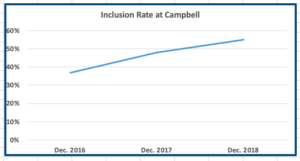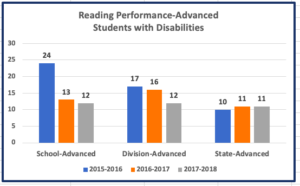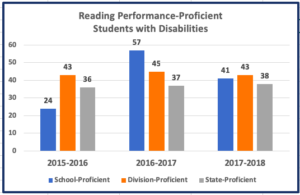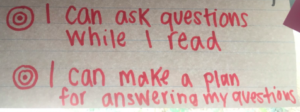Campbell students who receive special education services continue to outperform the state in English Language Arts.
Overview
Campbell has developed a culture to honor the diverse assets and needs of each student. This inclusive environment ensures that students with disabilities have access to the curriculum, school activities, and high quality instruction. About 22% of students at Campbell have an Individualized Education Program (IEP), including speech only students. Campbell’s special education population is comprised of students with a variety of disabilities and service levels. Students receive services that meet their individual needs in various settings, including a countywide program, group pull out instruction in a special education setting, and push in support in the general education setting.
Students with or without disabilities are able to access instructional and/or emotional support through a tiered system of supports. Campbell students have made significant reading improvement in part due to a robust offering of reading interventions, paired with a Reader’s Workshop philosophy. Professional Learning Communities (PLCs) comprised of grade level general educators, special educators, and second language educators work with reading coaches regularly to analyze student data and monitor student growth as measured by assessments and informal measures.
In 2015, the countywide elementary Interlude program, focused on serving students who have significant interfering behaviors that impede their ability to access the general education curriculum due to psychological or behavioral disorders moved to Campbell. The transition to Campbell strengthened the Interlude program’s focus on increasing students’ social and emotional functioning by providing a therapeutic environment designed to foster increased self-regulation, improved self-concept, positive relationship skills, and academic success. Students attending Campbell through Interlude and the program itself, have become integrated into the fabric of the greater school community. Students in the Interlude program are provided opportunities to participate in EL practices such as reflection, student led conferences, and passage presentations which serve as authentic opportunities for students to implement the skills they work so hard to master through their instruction within the program.
Inclusion Data
The inclusion rate at Campbell has increased over the past three years. Inclusion for this purpose is defined as time a student spends in a general education setting with non-disabled peers with or without support. The inclusion rate is the percentage of students who spend more than 80% of their day in general education. This data includes up to 20 students in the more restrictive Interlude program. For comparison purposes, the state percentage in 2016-17 was 64% and the Arlington percentage was 63%. In three years, Campbell approached the state level, even as the number of students in the Interlude program grew.
Master Class at National Conference on Inclusion
In the Fall of 20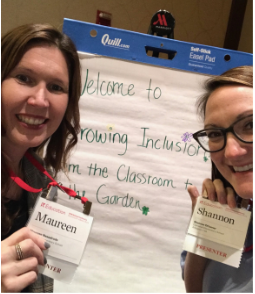 18, Shannon O’Connor, classroom teacher and Maureen Nesselrode, principal, presented a Master Class on Inclusion at the EL National Conference. The Master Class entitled, “Growing Inclusion: From the Classroom to the Garden” focused on ways that Campbell supports students through flexible grouping, setting and scheduling. Participants learned about the strategies we use at Campbell and developed a plan to increase inclusion in their own settings.
18, Shannon O’Connor, classroom teacher and Maureen Nesselrode, principal, presented a Master Class on Inclusion at the EL National Conference. The Master Class entitled, “Growing Inclusion: From the Classroom to the Garden” focused on ways that Campbell supports students through flexible grouping, setting and scheduling. Participants learned about the strategies we use at Campbell and developed a plan to increase inclusion in their own settings.
Reading Pass Rates
The pass rate for students with disabilities at Campbell has increased over the past several years. Campbell consistently exceeds the state pass rate. In the 2018 school year, the state changed testing exemptions for second language students, which directly resulted in many Campbell students taking the standardized test instead of using an alternate assessment.
This data shows that pass rates for students with disabilities at Campbell increased more dramatically from 2015-2016 to 2016-2017 than did the state or district. District results have remained flat. Campbell students with disabilities outperformed their counterparts across the state in all three years, including the SY 2018 when the alternate assessment was removed.
Reading Achievement
In the Fall of 2017, Campbell’s literacy team decided to transition to the Fountas & Pinnell (F & P) assessment instead of continuing the use of the Developmental Reading Assessment. For this reason F & P data is not available prior to 2017.
All special education students referenced in the analysis below received intervention in the form of either Orton Gillingham (OG) or Leveled Literacy Intervention (LLI). Student instructional levels included in the data findings were based upon the Fountas and Pinnell Benchmark Literacy Reading Assessment. What makes the findings below particularly compelling is that the “Instructional Level Expectations for Reading“ chart linked above has not been adjusted for students with disabilities. It is the identical chart used to mark progress of general education students as well.
During the 2017-2018 school year, the reading growth of 23 special education students receiving intervention in grades 3-5 was analyzed.
-
Of all 23 students, 65% made at least one year’s progress based on Fountas and Pinnell’s guidelines, while 52% made 1.5 years progress indicating they clearly exceeded annual growth expectations.
- All students (except for one) made at least .25 year’s growth.
- The one student who made negative growth can be explained by inter-rater reliability.
The graph below shows reading progress from beginning of the year (BOY) to middle of the year (MOY) during the 2018-2019 first semester.
- 18 out of 22 students, or 82%, made at least a half of a year’s progress (.5) while 45% of students exceeded expectations by progressing between .75 (three quarters of a year) – 1.25 (1 full year plus an additional quarter year).
- Four of the 22 students maintained their reading level, and though progress was noted by teachers, it was not enough to boost students to the next level.
Additional staff development was provided in the winter of 2019 for ESOL, special education and reading teachers providing intervention. The interventionists collaboratively problem solved pitfalls of intervention implementation and identified supplemental material to further support students.
Instructional Practices
In 2014, Campbell teachers began implementing a student centered reading and writing workshop in kindergarten through 5th grade. Students book shop to select books from the classroom library, read independently, participate in book clubs, reflect on their reading through text coding and make book recommendations to classmates. Teachers provide mini-lessons, small group guided reading and strategy groups, facilitate book clubs and confer with individual students. Implementing a workshop model in tandem with research based reading interventions has led to increasing reading stamina and improved comprehension skills among students. Each year, additional school based professional development is provide to assist teachers in furthering practices around workshop and the progress monitoring of students.
At Campbell ALL students have access to the same best practices during the literacy block, such as use of authentic texts, text-coding, leveled classroom libraries, and workshop structures. Books in all of Campbell’s classroom libraries span genres, topics, and reading levels ensuring there are titles that reflect the interests and needs of all readers.
Students use text coding during independent reading to capture their thinking. These post-it notes are then discussed during teacher conferencing and student peer conversations.
Special education and ESOL (English for Speakers of Other Languages) classrooms have high interest classroom libraries as do general education classrooms. Students sort and classify the books in their classroom libraries enabling them to more fluidly self-select titles based on their unique interests and reading readiness. This process increases student agency, directly impacting student engagement, which in turn results in an increase in the volume of students reading “just-right” materials. Reading environments are welcoming with alternate seating which encourage longer periods of independent reading. In addition to curating the books in their classroom libraries, students carefully and intentionally label the book baskets in ways that make shopping for materials a more appealing process. Click image for larger view.
Special education students use tools which enable them to successfully self-assess their literacy proficiencies while identifying new goals and helpful strategies to achieve them. They continuously monitor the progress they are making, celebrating approximations along the way and persevering until they reach their goals. Students understand this is an iterative process and therefore, realize the positive outcomes of a growth-mindset. Below are examples of individual student or group reflections and goals set to show how students reflect on their skills.
Students refer to learning targets in multi-age special education settings, as well as in general education classrooms.
Daily opportunities for students to independently undertake literacy activities aligned to their specific and unique goals are showcased below. Students participate in guided reading, workshop structures in general education inclusion settings as well as in special education settings. Within the same classroom, each activity featured below is differentiated to individual student needs.
Students in special education settings have choice and independent reading, in addition to research based instruction. In the picture below, note the reading box situated on the table next to one of the students. All students at Campbell have a similar personalized book box/bag filled with guided reading books and self-selected texts on the individual’s independent reading level.
Culture of Writing
Students publish their final writing pieces and post them on classroom writing walls. This contributes to a culture of writing across the school and provides an authentic audience for published work. Publishing parties at the end of each unit allow students to share their writing and celebrate their work with classmates and family members. Students provide feedback to classmates during publishing parties and throughout the writing process.
Students with disabilities participate in writer’s workshop. On the March 2019 5th grade writing prompt 60% of students with disabilities passed. Below are student writing samples from both inclusion and self-contained writing sessions.
Student Writing 1 Student Writing 2 Student Writing 3
Students in both inclusion and special education settings utilize the writing process to create high quality writing pieces. For example, in the sample below, one student revised his realistic fiction piece several times. Three versions are provided (edits are indicated in yellow and revisions are in teal). Over the iterations of the same piece, the student made not only grammar edits, but also changes to the structure and word choice within the piece. Additional details were added, unnecessary parts were deleted and some parts were rearranged. Both perseverance and high expectations in all settings at Campbell contribute to remarkable results in literacy.
 Contact
Contact  Calendars
Calendars Careers
Careers Engage
Engage  District
District

